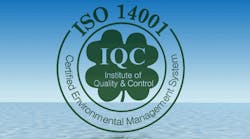ISO 14001 Revision Prompts Greater Focus on Environmental Compliance
In November 2011, the International Standards Organization (ISO) started a 3-year procedure to revise the ISO 14001 environmental management system standard. The revision is intended to better align the standard with current and future environmental and business conditions and practices. The revision is due to be published in 2015 and will impact the standard in terms of both structure and content. Once published, it is likely to remain unchanged well into the 2020s.
See Also: Workplace Environment Protection & Policy Information
Although voluntary, the ISO 14001 standard has become widely accepted as an essential tool to achieve environmental obligations and reduce environmental impacts wherever a company may operate in the world. For many companies, achieving ISO 14001 certification is the cornerstone of managing the interface between their business and the environment.
In particular, the revision likely will result in a higher demand for regulatory compliance services as the revision reflects a move toward integrating a more proactive approach to legal compliance. Companies may need to refocus the regulatory compliance part of their ISO 14001 management system to ensure they meet the new approach of the standard.
The ISO 14001 review (and the reform of the standard that appears likely to take place) may have a significant impact on how companies deal with environmental considerations as part of their business goals. This therefore will be highly relevant to the EHS directors, managers and employees responsible for implementing and maintaining management systems throughout the quarter of a million companies across 155 countries that are believed to have adopted the standard.
In terms of structural changes to the standard, the review of ISO 14001 is taking place in the context of the development of ISO's new "high level structure" for all its management system standards. The idea behind this is to create a harmonized approach to the structure of all standards in terms of using a common language, format and headings, which then can be used to build subject-specific standards. A copy of the proposed new structure can be downloaded from ISO's Web site (see Annex SL p141-154).
In terms of content, an ISO International study group has put forward 24 specific recommendations (IEMA, 2012) to improve the existing 2004 version of the standard (ISO, 2012), and the review committee is obliged to take these into account. The study group based its recommendations on research it undertook into the future challenges that businesses will face in the environmental context.
Changes Put Into Practice
The first draft of the revised standard is expected in Spring 2013, so we're still in the early days of identifying what the actual practical implications will be for industry.
-
On one hand, initial indications suggest that there will be a much wider approach taken to how businesses operate in, influence and connect with the environment around them. This stems from the move to harmonize the structure of all ISO standards. More specifically, all management system standards will be required to use the same high-level structure, with the following elements:
- Context of the organization
- Leadership
- Planning
- Support
- Operation
- Performance evaluation
- Improvement
Words such as "context," "leadership," "support" and "operation" imply that companies will need to look outward, both in the sense of considering external environmental factors, but also in the sense of have a broader outlook on environmental issues in general. Companies therefore will need to consider how their entire business strategy can impact the environment around them, and perhaps how they can influence their supply chains and customers – and, in turn, how unexpected and external environmental conditions can impact their business.
Although companies currently do use management systems to manage their impact on the environment, the environment increasingly is seen as a risk to business – in particular, external environmental risks and what to do about them in the long term. As a result, company strategies may need to consider issues such as climate change and water scarcity in the communities they operate in. Similarly, the continued availability of resources is a major concern for many businesses, so a more sustainable, outward-looking approach is becoming essential.
On the other hand, in terms of improving the content of the standard, it is worth noting points 12 and 20 of the aforementioned 24 recommendations. Point 12 states, "Address the concept of ‘demonstration of the commitment to legal compliance.'" There are different views on what the requirement for "commitment to compliance" should deliver in practice in certified EMSs – this variance could be addressed in the revision.
Point 20, meanwhile, states, "Clearly describe and communicate the approach/mechanism of achieving legal compliance in ISO 14001 (e.g. in the Annex)."
Survey Says
Many stakeholders and interested parties across the world have been or will be submitting papers and opinions to the review committee to provide valuable input. The Institute of Environmental Management and Assessment (IEMA) in the U.K., for example, carried out a survey among its membership in April 2012 that formed the basis of their submission to the ISO review committee. With 1,650 respondents, the survey generated some interesting results, which can be seen as a reflection of wider opinion among practitioners:
- 92 percent of respondents wanted ISO to clarify how organizations should demonstrate their commitment to compliance.
- 90 percent agreed with a requirement that organizations should be required to demonstrate knowledge and understanding of their legal compliance status.
It is clear, therefore, that refocusing and clarifying the provisions on legal compliance are two of the main priorities of the revision. In practice, this likely will compel companies to better demonstrate their compliance status on an ongoing basis rather than reacting to audit findings after the event.
Tjeerd Hendel-Blackford is a program and business development manager with Enhesa. He has over 10 years of experience as an EHS policy, regulatory and management expert. He holds affiliate membership of IOSH and is an associate member of IEMA.

